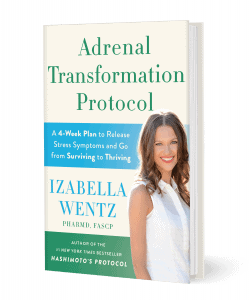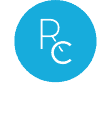When I began my healing journey from Hashimoto’s, I was amazed at how going gluten and dairy free resolved my acid reflux and IBS in just three days, and my carpal tunnel was gone a few weeks later.
But I continued to have fatigue, especially morning fatigue, brain fog, anxiety, and unrefreshing sleep, despite being gluten and dairy free and already taking thyroid medications.
Some integrative professionals mentioned the term “adrenal fatigue” to me, and I looked up the condition on Dr. Google. The results were not impressive. The “authoritative” medical websites I reviewed said, quite simply, that adrenal fatigue did not exist. So being a skeptical pharmacist, I moved on from the topic and looked for other solutions.
The coconut oil on my neck did not work, LOL.
A weird acupressure practice that promised to help with my fatigue also did not help!
And I kept hearing about adrenal fatigue and dismissing it… until finally, after the 15th person mentioned it, I decided to look deeper into it and realized that I had just about every symptom! Lo and behold, after trying the recommendations for adrenal fatigue, my brain fog, fatigue, anxiety, and need for extra sleep improved significantly! I have been sharing about this condition for 10+ years now, and it does exist, but it is controversial. Here’s why:
Dr. James Wilson, a well-known naturopathic doctor, brought the term “adrenal fatigue” to light in his book, Adrenal Fatigue: The 21st Century Stress Syndrome, published in 2001. He used the term to describe a cluster of symptoms — fatigue not relieved by sleep, craving salt foods, decreased ability to handle stress, mild depression, symptoms worse when meals are skipped, weight gain, and low sex drive — often brought on by a period of chronic stress.
He described adrenal fatigue as the adrenals’ decreased ability to produce stress hormones, almost like a mild version of Addison’s disease (a rare autoimmune condition which can be life-threatening and requires lifelong hormone replacement).
While his description was certainly useful for describing the symptoms that people experience, his description of how the adrenals function when overloaded with chronic stress wasn’t entirely accurate.
Since the introduction of adrenal fatigue, the term has been surrounded by controversy. Some claim it doesn’t exist and there’s no evidence to support this syndrome. Others find that the term is the only thing that accurately describes their symptoms, and when they follow suggested protocols, their symptoms resolve.
I’ve found this cluster of symptoms to be very real in many people (including myself!), but I wouldn’t categorize it as a disorder or a disease. Rather, it’s a predictable way the body responds to stress, or a stress adaptation, and while I sometimes use the term adrenal fatigue, or burnout, to describe how someone with the condition may feel, hypothalamic-pituitary-adrenal (HPA) axis dysfunction is a more medically-accurate term. I, along with other integrative practitioners, have settled on “adrenal dysfunction” to make the medically-accurate term a bit more approachable. 🙂
In my decade of working with people with Hashimoto’s and hypothyroidism, I’ve also found that there’s often a connection between thyroid issues and the adrenals, and many people don’t fully resolve their symptoms until they address the health of their adrenals. I used to recommend extreme lifestyle changes like quitting all caffeine and sleeping 10-12 hours a night to support the adrenals, as well as using hormones to mimic a healthy circadian cortisol response. However, in the last five years I have found that there’s a more predictable way to shift the body out of the stress overwhelm!
I’m so happy to shed some light on the confusion and misunderstanding about what’s actually happening in the body during periods of extended chronic stress, and how to finally heal.
Adrenal Fatigue Controversy
Most conventional doctors and endocrinologists reject the idea of adrenal fatigue as a real condition, and typically only recognize two adrenal conditions — Addison’s disease (when the adrenals produce too little cortisol) and Cushing’s syndrome (when the adrenals produce too much cortisol). Both conditions can be life-threatening if left untreated, and are rare compared to Hashimoto’s and adrenal dysfunction.
There is, however, a gray area where someone may not have either of those conditions, but their stress response system is not operating optimally. These people usually experience symptoms like fatigue, brain fog, weight gain, decreased sex drive, feelings of overwhelm, and anxiety.
The term “adrenal fatigue” suggests that the adrenals are no longer producing the right amount of cortisol because we have “tired” them out. As we’ve come to find, this is not entirely accurate. The adrenals may be totally healthy and capable, but there’s a breakdown of communication in the hypothalamic-pituitary-adrenal (HPA) axis, and desensitization of certain receptors, that can lead to the symptoms associated with adrenal fatigue.
Many doctors point out that “adrenal fatigue” isn’t an accurate term, and I agree. But when we focus on the inaccuracy of the name itself, we overlook the fact that there is a very real issue that people are experiencing, and people continue to suffer. In fact, HPA axis dysfunction is well documented in scientific literature.
More recently, there’s controversy about adrenal fatigue in the natural world, too. Some practitioners attribute adrenal dysfunction symptoms to other things, like childhood trauma, mitochondrial issues, mold toxicity, sleep apnea, or nutrient deficiencies.
While there are certainly causes and co-occurring conditions that can impact the stress response, it’s important to note that adrenal dysfunction itself is not a disease. Rather, it’s how the body responds when overwhelmed with stress.
It’s also important to note that “stress” isn’t just psychological stress. Stress can be anything that overwhelms our ability to cope, including stress from physical causes like mold exposure, sleep apnea, chronic pain, and nutrient deficiencies.
Additionally, when a person has a root cause like mold toxicity, a pathogen or infection, or sleep apnea, a part of the healing journey needs to focus on rewiring the stress response, or what I call, my Adrenal Transformation Protocol. 🙂
We could argue over semantics all day, but then we would be missing the point, which is that many people are experiencing this cluster of vague symptoms that greatly impact their health and quality of life (and more importantly, there is a way out!). When we become dismissive of this, people are left without resources and can go untreated for years.
How Does Adrenal Dysfunction Work?
So, if the adrenals don’t become “fatigued,” what exactly is happening?
The problems generally originate in a communication breakdown within the hypothalamic-pituitary-adrenal axis, known as the HPA axis. The HPA axis describes the interactive feedback loop that takes place between these three endocrine glands.
The hypothalamus is like the CEO of our body’s production of hormones. It scans messages from our environment and other endocrine glands, and checks the body’s overall hormonal status before passing on the order for more hormones to the pituitary gland. The pituitary gland then acts as a project manager and will pull together individual workers (like the thyroid gland, the adrenal glands, and the gonads) to do their jobs. The pituitary also ensures that the workers have adequate resources to do their jobs by managing growth and repair, as well as electrolyte/water balance.
The HPA axis is the system that’s initiated when we experience stress — whether that stress is emotional, mental, or a physical threat to our safety. In the case of chronic stress, the never-ending presence of stressful yet non-life-threatening situations, can lead to the constant activation of the stress response.
To help meet the demand for cortisol, the body will decrease production of other hormones produced by the adrenals, such as progesterone, DHEA, and testosterone.
Eventually, with enough chronic stress, the HPA axis becomes overwhelmed and desensitized to the usual feedback loop, and stops sending messages to the adrenals to produce more hormones or less hormones, no matter what’s happening. Additionally, a person may run out of the nutrients required for proper adrenal function.
The adrenals are capable of producing adequate amounts of hormones at the right times, but they’re not getting the right signals, or they’re not receiving the signals correctly. While not a disease per se, adrenal dysfunction is an example of non-optimal functioning that can cause real symptoms for people.
My Adrenal Dysfunction Story
I still remember when my integrative doctor suggested I get tested for adrenal fatigue after my Hashimoto’s diagnosis over a decade ago — I was skeptical.
I delayed testing my own adrenals for a long time, and this kept me anxious, fatigued, and overwhelmed for far longer than I needed to be.
It wasn’t until I spoke with another pharmacist, Carter Black, RPh, about the symptoms I was experiencing, and he suggested that I have my adrenals tested, that I decided to give it a try. Maybe I was more open to it because he was a fellow pharmacist and wasn’t trying to sell me anything, or maybe the timing was just right.
Sure enough, the integrative adrenal test showed that I had an advanced stage of adrenal dysfunction. I followed the recommended protocols and saw incredible improvements in my energy levels, emotional state, blood sugar issues, and hormone balance.
On my healing journey I paid out of pocket for expensive tests like the adrenal saliva test, took pregnenolone, DHEA, and hydrocortisone, quit caffeine, and slept 10-12 hours for 30 days straight to rebalance my adrenals. While these protocols are useful and effective, and worked for me, they have limitations.
Many people don’t have access to testing or hormones, or the ability to sleep 10-12 hours per day. Quitting caffeine can certainly support the adrenals, but might feel impossible for someone who currently relies on it to get through the day.
I’ve encountered adrenal dysfunction two more times since that first bout. The most recent time, after the birth of my son, challenged all my tried and true protocols. I wasn’t able to sleep for 10-12 hours per night with a newborn, and there was no way I was giving up caffeine, as it helped me get through my days. I wasn’t comfortable using hormones while breastfeeding. I had to find a different way to support adrenal healing.
I came up with new protocols that focused on giving my body “safety signals.” I believe that our bodies are always scanning our environment for messages and adapting accordingly. Stress signals like toxins, infections, nutrient deficiencies, lack of sleep, over exercising, and emotional stress tell our body that the world is not safe, and to downregulate certain functions, which can cause symptoms like persistent fatigue. While this may seem annoying and inconvenient to us in the modern world, it’s actually the body’s way of protecting us and ensuring our survival.
On the other hand, when we send our bodies safety signals like low stress, plenty of nutrients, joy, and sleep, the body feels safe enough to thrive, and symptoms like fatigue, brain fog, and weight gain can disappear.
So I focused on flooding my body with as many safety signals as possible, and I was pleasantly surprised when my gentle, sustainable approach to healing my adrenals worked! My symptoms resolved quickly, and I not only recovered, but was able to thrive as a new mom.
How to Transform Your Adrenals
I was thrilled to have found a way to support the adrenals without expensive testing, hormones, 10-12 hours of sleep, or giving up caffeine. I began utilizing this protocol with my clients who had symptoms of adrenal dysfunction, and they experienced amazing results, just like I did.
In 2020, I officially launched my Adrenal Transformation Program. The program delivered mind-blowing results to participants, and most of them started feeling better in as little as 3-4 weeks. These are some of the improvements that participants experienced:
- 92% had reduced mental fog
- 89% reported reduced fatigue
- 89% reported reduced forgetfulness
- 86% reported reduced anxiety
- 85% felt less irritable
- 81% experienced less trouble sleeping
- 81% improved their libido
- 78% reduced feelings of depression
- 76% reduced their joint pain
Over 3,500 people have now been through the program, and participants continue to experience these incredible results.
Recently, I had a full circle moment when I saw a continuing education course for pharmacists about subclinical hypothyroidism referencing my work and my books. This surreal moment, and seeing just how much success people were having on the Adrenal Transformation Program, lit a fire under me – I wanted to put adrenal dysfunction on the map, just as I had with Hashimoto’s and hypothyroidism.
After working for years to help people with Hashimoto’s and hypothyroidism, and seeing how much more information is available now versus when I was diagnosed, over ten years ago, I felt inspired to do the same for adrenal dysfunction. I wanted to create awareness about it and offer solutions to help people.
For years, I’ve worked with people who are in limbo with their health. They experience brain fog, fatigue, and irritability, and their doctors can’t find a “cause” or offer them any real help. They’re not full-blown sick, but they’re not quite well. They get lost and overlooked in the conventional medical system, and some end up suffering for years. It’s disheartening to see so few resources for these people.
If I was going to come out of maternity leave and write another book, it had to be a good one. I decided that taking my Adrenal Transformation Program and putting it into a book that anyone could access was the perfect first step to raising awareness around adrenal dysfunction, and I got to work.
Adrenal Transformation Protocol
That is how my newest book, Adrenal Transformation Protocol, was born. In it, you’ll find a simple four-week program to help you balance your stress response and gradually build up your resilience, to prevent excess stress from overwhelming your adrenals. Adrenal Transformation Protocol will set you up with a strong foundation to return to and stay in homeostasis through turbulence.
This book is for anyone experiencing brain fog, fatigue, sleep issues, chronic pain, low libido, and/or mood issues. If you have come to a healing plateau in your thyroid journey or are looking for a way to become more resilient in the face of all the stress life throws at you, this book can truly transform your health.
Or maybe you know something is off despite normal lab tests, or you’re having trouble finding resources and support for adrenal dysfunction — then this book is for you!
When we start supporting the adrenals — making a few small dietary and lifestyle changes and taking the right supplements — we can produce profound improvements in energy levels, feel calmer, and allow our body to repair itself, within weeks or even days. You can get a new lease on life and feel like yourself again in just a few short weeks!
I’m so excited to share this book with the world — you can order your copy here! 🙂
For future updates, make sure to follow me on Facebook, Instagram, TikTok, and Pinterest!
P.S. Would you take a moment and share this information with anyone who you think might benefit from it? I’m on a mission to spread hope and help as many people as I can!


 Disclosure: As an Amazon Associate I earn from qualifying purchases. We are a professional review site that receives compensation from the companies whose products we review. We test each product thoroughly and give high marks to only the very best. We are independently owned and the opinions expressed here are our own.
Disclosure: As an Amazon Associate I earn from qualifying purchases. We are a professional review site that receives compensation from the companies whose products we review. We test each product thoroughly and give high marks to only the very best. We are independently owned and the opinions expressed here are our own.
Leave a Reply